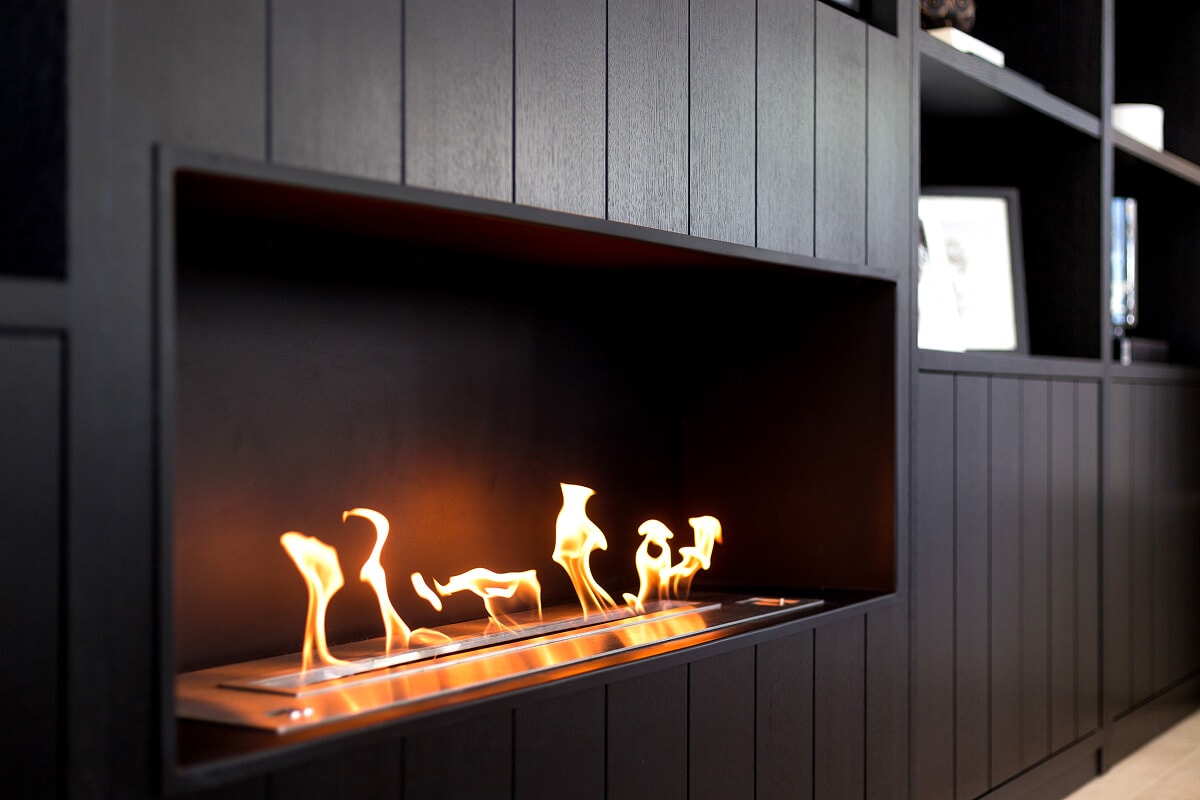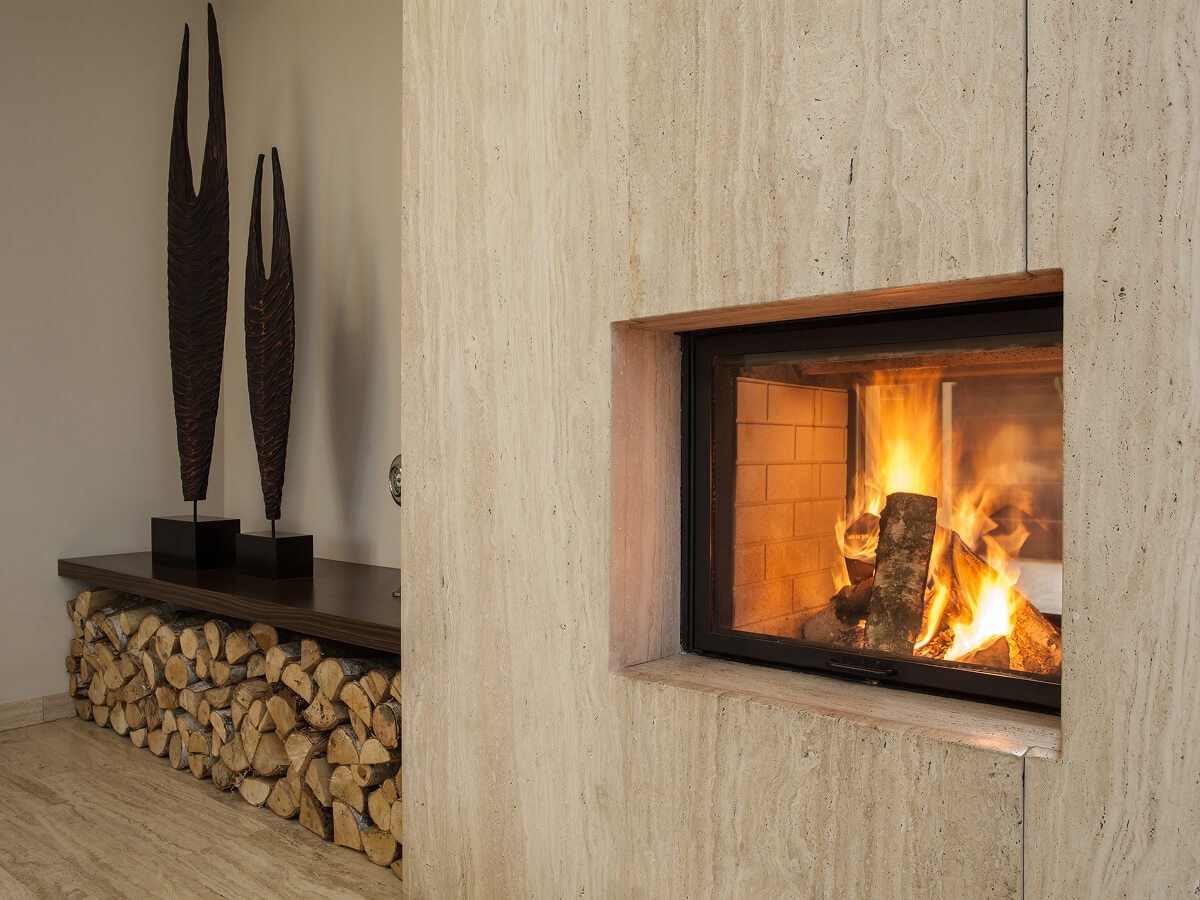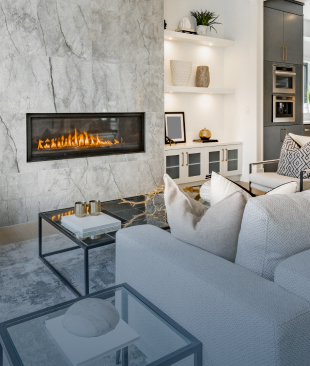In an era of rising home costs and shifting energy priorities, one number is catching Canadian homeowners’ attention: $4,500. That’s the potential difference in installation costs between an electric fireplace, starting at around $500, and a gas model, which can reach $5,000.
The growing gap isn’t just about price. Electric fireplaces are becoming recognised for their affordability, easy setup, and minimal upkeep. But gas remains a pillar, prized for its high heat output, lifelike flame, and reliability during winter outages.
With both options offering distinct advantages, the fireplace market in 2025 is less a battleground and more a balancing act. As homeowners weigh performance, efficiency, and lifestyle fit, the real choice is what provides the most satisfaction for the modern Canadian.

The Rise of Electric Fireplace Models
Over the past decade, electric fireplace models have seen increased adoption, particularly in metropolitan areas. Available in a range of formats, from wall-mounted panels to traditional-looking inserts, electric units are often selected for their ease of installation. Unlike gas models, electric fireplaces do not require ventilation and can be set up by plugging them into a standard outlet.
Their popularity is also linked to convenience. For renters or condo residents, electric fireplaces offer a heating solution without the need for a licensed contractor or alterations to the home’s structure. These models provide both visual flame effects and supplemental heat, skyrocketing their rise across Canadian households.
Gas Fireplaces Remain Dominant in 2025
While electric fireplace units have grown in popularity, gas fireplaces still maintain a greater share of the Canadian market. According to data from the Hearth, Patio & Barbecue Association Canada, over 3.2 million homes across Canada are equipped with a gas fireplace. In comparison, approximately 1.5 million households use electric fireplace units.
Usage patterns suggest that gas fireplaces, particularly direct-vent models, remain a central part of home heating. An estimated 500,000 Canadians rely on gas fireplaces daily during winter months, accentuating their role in colder climates. This preference is often attributed to the higher heat output of gas systems and their ability to operate independently of electrical systems during outages.
You can explore common models here: Gas Fireplaces – Toronto
Fireplace Costs at a Glance: What You Need to Know
The cost of installing and operating a fireplace in 2025 depends on key considerations including pricing, installation costs, maintenance requirements, operational expenses, and energy efficiency over time.
Electric fireplace models generally offer lower upfront and installation costs, making them more accessible for renters or homeowners seeking secondary heat sources. However, gas fireplaces often produce higher heat output and may reduce reliance on central heating systems particularly in colder provinces.
Long-term planning also plays a role. For homeowners planning to stay in place for several years, the heating efficiency of gas may offer more consistent performance over time. Those planning to relocate sooner may prioritize the flexibility and lower installation costs associated with electric options.
Which Is the Cheapest to Run, a Gas or an Electric?
Operational costs remain one of the most important distinctions between gas and electric fireplaces in 2025. According to estimates from Direct Energy:
- A 1,500-watt electric fireplace running at 12¢/kWh costs approximately $0.18 per hour to operate. At two hours of use per day, this amounts to roughly $10.80 per month.
- A natural gas fireplace, by comparison, averages about $28.80 per month for the same amount of usage.
- Homes using propane can expect significantly higher costs: around $1.10 per hour, or $66 per month based on 60 hours of use.
|
Feature |

Electric Fireplace |

Gas Fireplace |
|---|---|---|
| Installation | Plug-and-play | Professional required |
| Ventilation Needed | ✕No | ✓Yes |
| Structural Changes | ✕No | ✓Often |
| Best For | Renters, condos | Detached homes |
For households using a fireplace as a supplementary heat source for a single room, electric units remain a cost-effective option.
How Much Does It Cost to Convert a Fireplace to Gas?
Homeowners with an existing wood-burning fireplace may consider conversion to gas for convenience and cleaner operation. This process typically involves installing a gas fireplace insert, adding a dedicated gas line, and contracting a licensed technician for professional installation.
Costs for a full conversion vary based on regional labour rates, the home’s layout, and access to utilities. Most conversions range from several thousand dollars, though the final figure depends heavily on individual circumstances.
While it’s a significant investment, many homeowners make the switch for convenience, safety, and improved efficiency. Learn more from providers like The Fireplace Store.
Gas vs Electric Fireplace Installation Costs in 2025
Installation Costs in 2025: Gas vs Electric
Installation remains one of the clearest cost divides between gas and electric fireplace models.
- Electric fireplace installation typically ranges from $500 to $2,500, depending on the complexity of the design and whether the unit is freestanding or built-in.
- Gas fireplaces, by contrast, require more infrastructure. Total installation costs can fall between $2,750 and $5,000, with pricing driven by gas line requirements, venting systems, and the need for certified labour. Permits and inspections may also add to the total cost.
What Professional Installation Involves
When installing a gas fireplace, licensed professionals must assess the home, install a natural gas line, ensure proper venting, and verify that the system complies with local building codes. Carbon monoxide risk, ventilation, and long-term safety are key considerations, making professional installation non-optional for gas units.
Electric fireplaces, by comparison, require minimal setup. Many models are designed for wall mounting or standalone use. In cases where a built-in electric unit is desired, professional help may be needed, but the process is typically less invasive and less costly than gas installation.
Gas Line Requirements and Costs
Installing a gas fireplace in a home without a pre-existing gas line may significantly raise project costs. Adding a line involves excavation or routing through walls, pressure testing, and adherence to utility provider protocols. Costs vary widely based on the home’s infrastructure and the location of the nearest gas hookup.
Safety remains a core issue. Ensure proper ventilation and pressure testing, as improper gas line installation can increase the risk of gas leaks or carbon monoxide exposure. Considering these significant risks, technicians and ongoing inspections are strongly recommended.
Electric Installation: Lower Costs, Fewer Requirements
Most electric fireplace units can be wall mounted or placed freestanding. Even built-in models generally require less structural work than gas systems, due to the absence of ducts, vents, or fuel lines. These units also have minimal maintenance demands. Without gas or flame, routine upkeep is a rarity, and the absence of chimneys or venting systems reduces long-term costs. For homeowners prioritizing simplicity and lower installation barriers, electric fireplaces present a practical option.
Chimney Cleaning Requirements: Wood vs Gas vs Electric
- Wood-burning fireplaces require annual chimney cleaning to reduce the risk of creosote buildup, which can lead to chimney fires. This maintenance can be a nuisance, but is essential for safety and is an ongoing cost for homeowners.
- By contrast, gas fireplaces produce no creosote or soot, reducing the need for regular chimney cleaning. These systems may still require periodic inspection but do not demand the same level of chimney maintenance as wood-burning units.
- Electric fireplaces, which do not produce combustion or emissions, require zero chimney cleaning at all, eliminating the lifetime cost entirely for users.
Annual Gas Fireplace Maintenance Explained
Gas fireplaces require routine checks to ensure safe operation. This includes inspecting the pilot light, burner, and ventilation system, with annual maintenance costs averaging several hundred dollars.
Electric units demand little more than occasional cleaning. Without flame or fuel, they eliminate risks associated with soot buildup, gas leaks, or blocked vents. Maintenance is generally limited to cleaning the unit or replacing lightbulbs. As a result, electric units offer lower long-term servicing costs.

Heat Output & Performance
Heat Output Comparison: Electric vs Gas
Heating capacity remains a key differentiator between gas and electric units. According to Direct Energy, a typical electric fireplace produces around 1.5 kW of heat, equivalent to roughly 5,000 BTUs, enough to warm a 400 sq ft space. These systems are often used for zone heating in bedrooms or small living areas.
Gas fireplaces typically deliver between 20,000 to 40,000 BTUs per hour, with sufficient output to heat entire floors or open-concept spaces. Natural Resources Canada identifies gas models as viable primary heating sources, even during winter extremes in colder provinces.
Energy Efficiency: Which Is More Effective?
Electric fireplaces convert electricity into heat with 100% efficiency, meaning all power drawn results in usable warmth, and no heat is lost through vents or flues. Gas fireplaces have more variation in efficiency, typically ranging between 50% and 85% depending on the model and design. Heat loss through ventilation systems lowers the effective output. High-efficiency gas fireplaces can approach the performance of electric models, but most still trail behind in raw efficiency.
This performance difference has implications. For example, a 20,000 BTU gas fireplace at 70% efficiency provides the same usable heat as a 40,000 BTU model at 35% efficiency. This insight from Natural Resources Canada highlights why selecting a high-efficiency gas unit is essential if you’re leaning toward gas. Over time, your energy savings will add up.
What Are the Disadvantages of Electric Fireplaces?
While electric fireplaces boast straightforward installation and minimal operating costs, they still come with limitations.
- Lower heat output may be insufficient in colder regions or larger spaces.
- Dependence on electricity means they provide no heat during power outages, unlike some gas models that can operate without electrical input.
- Some users also find the absence of real flames detracts from the experience, even with modern flame simulation technologies.
Environmental Impact & Safety
Carbon Emissions: Natural Gas vs Electric
Electric fireplaces produce no indoor emissions, including carbon monoxide, smoke, or particulates, making them a safer choice for those with asthma, allergies, or other respiratory conditions.
In contrast, gas fireplaces emit carbon dioxide (CO₂), carbon monoxide (CO), and water vapour, all of which must be properly vented to avoid safety hazards.
Carbon Pricing and the Future of Natural Gas Heating
Canada’s carbon pricing framework also influences the long-term cost of operating gas fireplaces. As of 2023, the federal carbon levy added approximately $0.09 per cubic metre of natural gas, resulting in an estimated $9 annually for typical fireplace usage.
This figure is expected to rise gradually through 2030, according to the David Suzuki Foundation. While the increase is modest in the short term, it may have a growing impact on household energy budgets in the years ahead.

Do Electric Fireplaces Have a Lower Carbon Footprint?
The carbon footprint of electric fireplaces varies by province. In British Columbia, where approximately 98% of electricity is generated from renewable or low-emission sources (primarily hydro power), the environmental benefits of electric fireplaces are especially clear.
As BC Hydro notes, electric fireplaces in the province are effectively zero-emission at the point of use, making them a fitting choice for households aiming to lower their carbon footprint.
Are Gas Fireplaces at Risk of CO Leaks?
Carbon monoxide (CO) is an odourless, colourless gas that can be fatal in high concentrations; even small, undetected leaks may lead to long-term health effects. According to Health Canada, around 300 Canadians die annually and 200 are hospitalized due to unintentional CO exposure.
Because gas fireplaces use combustion, annual inspections, proper venting, and functioning carbon monoxide detectors are crucial for safe use.
CO Detector Regulations Across Canada
Some provinces have implemented mandatory safety regulations. In Ontario, for example, CO detectors must be installed near all sleeping areas in homes with fuel-burning appliances or fireplaces. This requirement is part of the Ontario Fire Code, and is enforced by local authorities such as Central York Fire Services.
Fireplace Technology and Features
Modern Electric Fireplaces
Electric fireplace technology has advanced significantly. Contemporary units often include remote controls, smartphone compatibility, and programmable settings. Many models also feature realistic flame simulations using LED lighting or holographic projections.
These updates allow users to adjust heat levels and visual effects easily, making modern electric fireplaces a more versatile and user-friendly option, particularly for condos, apartments, or homes undergoing renovation.
Direct-Vent Gas Fireplaces
Recent innovations in gas fireplace design have led to the rise of direct-vent systems, which are now widely regarded as the industry standard. These units use a sealed combustion system, drawing air from outside and expelling combustion gases through exterior vents, improving indoor air quality, reducing heat loss, and increasing safety.
Efficiency Standards and Certifications
EnerChoice Ratings in 2025
Canada has adopted stricter efficiency guidelines for home heating systems, including fireplaces, using the EnerChoice certification. This sets minimum efficiency standards across different unit types:
- Fireplace inserts: minimum 61% fireplace efficiency (FE)
- Freestanding stoves: 66% FE
- Built-in units: 62.4% FE
These ratings are designed to give consumers clear, standardized data about how efficiently their fireplaces operate.
According to FortisBC, all gas fireplaces in Canada also carry an EnerGuide label, which provides a range-based efficiency score. These typically span from 20% to 70%, depending on the unit’s design.
Comparing Efficiency: Electric vs Wood
Efficiency comparisons reveal the shortcomings of traditional wood-burning fireplaces, which convert only 10% or less of their fuel into usable heat. The remaining 90% is typically lost through the chimney.
Unlike wood, electric fireplaces are 100% efficient, converting all electricity into room heat. Gas fireplace inserts also perform well, typically reaching 70% to 80% efficiency, depending on the model.
Usage Trends and Fireplace Inserts
Fireplace Inserts: Upgrading Existing Units
Many Canadian homes feature traditional fireplaces that are either inefficient or no longer in regular use. Fireplace inserts, available in both electric and gas formats, provide a solution that improves heat output, safety, and aesthetic appeal without the need for major renovations.
Gas inserts generally feature sealed combustion and glass enclosures; electric inserts are often plug-in units and require no ventilation, making them especially accessible. Both options provide an effective way to modernize older fireplace cavities and bring them up to current performance standards.
Ventless Gas Fireplaces: Key Considerations
Ventless gas fireplaces, while appealing for their low installation requirements, introduce potential risks to indoor air quality, releasing combustion by-products such as water vapour and trace gases directly into living spaces.
According to the International Association of Certified Home Inspectors (NACHI), a 30,000 BTU ventless gas heater can generate nearly one gallon (about 3.8 litres) of moisture every 3 hours, or roughly 1.3 litres per hour. In homes without sufficient ventilation, this level of humidity can contribute to condensation, mold growth, and overall degradation of indoor air quality. Due to these risks, vent-free fireplaces face tight regulation across Canada, with some provinces banning their use entirely.
Heating Scope and Limitations
Although both gas and electric fireplaces can deliver substantial heat output, experts advise against using them as primary home heating systems. Instead, they are better suited to zone heating, providing targeted warmth to specific rooms or areas. This approach enables homeowners to manage energy use more efficiently by warming only the most frequently used spaces.
Safety and Health Risks
Surface Temperature Hazards: Comparing Gas and Electric
Gas fireplaces often feature sealed, tempered glass fronts to contain combustion, but these surfaces can reach dangerously high temperatures. Parachute Canada reports that the glass on gas fireplaces can exceed 400°F (200°C) within just six minutes of operation, and may remain hot enough to cause burns for up to 45 minutes after use.
In contrast, electric fireplaces typically operate at much lower surface temperatures. While they may become warm, they are generally considered safer in homes with young children or vulnerable individuals.
|
Requirements |

Electric Fireplace |

Gas Fireplace |
|---|---|---|
| Requires gas line | ✕ No | ✓Yes |
| Ventilation needed | ✕No | ✓Yes |
| Licensed contractor required | ✕Optional | ✓Mandatory |
| Permit/inspection required | ✕Rarely | ✓Frequently |
| Structural changes | ✕Minimal | ✓Often Significant |
Burn Risk for Children
Children under the age of five are especially at risk of burn injuries from gas fireplace glass. Young children may touch heated surfaces out of curiosity, unaware of the danger. Numerous burn incidents involving toddlers have been documented due to accidental contact with gas fireplace fronts, whereas the lower surface temperature of electric fireplaces makes them a safer alternative in family homes.
Cost Deep Dive: Operational and Energy Use
Hourly Cost Comparison
Operational cost is a key factor for many homeowners evaluating fireplace options. Based on estimates from Direct Energy, the typical per-hour running costs in 2025 are as follows:
- Electric fireplace: approximately $0.18/hour or $10.80/month for two hours of daily use
- Natural gas fireplace: around $0.48/hour
- Propane fireplace: approximately $1.10/hour
Among these, propane is the most expensive option for regular use, while electric models remain the most cost-effective for short-term or occasional heating.
Energy Price Comparison: Gas vs Electricity
Natural gas continues to offer lower per-unit energy costs compared to electricity. Natural Resources Canada estimates that gas averages approximately $12 per million BTUs, whereas electricity costs around $36 per million BTUs. This price gap means gas fireplaces often provide more affordable heating over time despite higher upfront installation and maintenance costs.
Long-Term Affordability of Electric Units
While electricity may cost more per BTU, electric fireplaces benefit from minimal installation requirements and virtually no ongoing maintenance. Such savings can offset the higher energy price over time. The absence of chimneys, gas lines, and combustion systems also simplifies ownership and reduces long-term costs.
Older Gas Fireplaces: Efficiency Concerns
It is not uncommon for older gas fireplace models, predominantly decorative units, to operate at just 30% to 40% efficiency. Replacing outdated systems with high-efficiency gas inserts or modern electric fireplaces can lead to substantial energy savings and improved performance.
Fireplace Types and Installation Formats
Wall-Mounted Electric Fireplaces
Wall-mounted electric fireplaces are increasingly popular in modern home design, particularly in apartments and renovation projects where space is limited. These units do not require floor space, venting, or a hearth, making them suitable for contemporary interiors. In addition to offering efficient zone heating, wall-mounted models provide a sleek visual focal point.
Gas Logs vs Inserts: Understanding the Difference
Gas logs replicate the look of traditional wood-burning fireplaces but are generally less efficient, as they often rely on open combustion. Heat output tends to be lower, and indoor air quality may be impacted due to the lack of a sealed system.
Gas inserts, by contrast, are enclosed systems designed to increase both efficiency and safety. These models reduce energy consumption by containing combustion and directing heat more effectively into the room.
Converting Traditional Fireplaces
Homeowners with existing wood-burning fireplaces frequently opt for electric or gas inserts as part of an upgrade. In many cases, the conversion process can be completed without major structural changes to the fireplace cavity.
Thinking of making a change to your fireplace? Explore conversion options here.

Future Trends and Regulatory Shifts
Efficiency Standards and Phase-Out Policies
Natural Resources Canada has proposed a minimum fireplace efficiency (FE) of 50% for new gas units, marking a shift toward stricter performance criteria. British Columbia is also exploring performance-based regulations for new installations, further encouraging the widespread adoption of higher-efficiency models.
These changes are part of broader efforts to reduce greenhouse gas emissions and improve the energy performance of residential heating systems. As regulations evolve, direct-vent gas units and electric fireplaces are expected to become the dominant technologies.
Final Thoughts: Gas vs Electric
Prioritising the optimal fireplace for your needs depends entirely on your personal objectives. For homeowners in search of low-cost installation, simplicity, and minimal maintenance, electric fireplaces provide a practical, eco-friendly solution. For those prioritizing powerful heat output, real flames, and a traditional aesthetic, gas fireplaces remain a strong option, though typically at a higher upfront and maintenance cost.
Taking time to evaluate each model’s functionality, efficiency, and long-term value can help ensure you make a well-informed decision that aligns with both your lifestyle and your home’s heating needs.
The Fireplace Store: Your Ideal Fireplace Starts Here
Maybe you’re drawn to the cozy glow of real flames, or the sleek convenience of plug-and-play warmth. Whatever your preference, the right, properly installed, fireplace can totally transform your space. At Toronto’s Fireplace Store, we’ve spent over 25 years helping homeowners like you install a fireplace setup that creates an efficient, elegant and comfortable home environment.
As Canada’s largest fireplace showroom, we offer 100 stunning displays from over 20 exclusive brands for you to choose from. From direct-vent gas models built for harsh Canadian winter, to wall-mounted electric units that connect seamlessly with urban condos, our friendly team is here to help you make a tailored choice to make the most out of your space.
Ready to upgrade your space with a fireplace that’s built to last and styled to impress? Contact us today and let us help you bring new levels of warmth to your home.


 Website Design and SEO by dNovo Group | © 2024 All Rights Reserved – The Fireplace Store
Website Design and SEO by dNovo Group | © 2024 All Rights Reserved – The Fireplace Store



